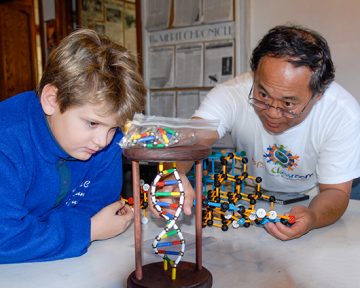 I found this article by John Ewing fascinating because it dances around who or what is to blame for why so many students struggle in college.
I found this article by John Ewing fascinating because it dances around who or what is to blame for why so many students struggle in college.
Rather than blaming incompetent teachers as many do, he brings up interesting facts about colleges admitting more students for financial gain (HINT: more tuition dollars means more profit for the colleges). Check it out!
 I found this article by John Ewing fascinating because it dances around who or what is to blame for why so many students struggle in college.
I found this article by John Ewing fascinating because it dances around who or what is to blame for why so many students struggle in college.
Rather than blaming incompetent teachers as many do, he brings up interesting facts about colleges admitting more students for financial gain (HINT: more tuition dollars means more profit for the colleges). Check it out!
My high school buddy and college suite-mate, Steven Yoshinaga, came to Merit Academy to teach students chemistry using Molecular Mania, a game he created to make learning chemistry fun.
Leave it to “Yosh” to make learning about DNA and chemical bonds exciting. Check out all of his ZomeTool science games: DNA, Crazy Bubbles and Molecular Mania on Amazon.com. http://www.zometool.com/products/molecular-mania.html

 As if this waiting period isn’t stressful enough, having to deal with being placed on admission waitlists is just, well, cruel!
As if this waiting period isn’t stressful enough, having to deal with being placed on admission waitlists is just, well, cruel!
You should be receiving admissions letters during the month of March – Good luck! – and sometimes as late as the first few weeks of April. Yup, I know how stressful this is. But here are a few tips on what to expect and what to do:
Do:
1. Definitely accept admission to one of the colleges from which you have received an admission offer. In other words, don’t decline admission to all of the colleges and cross your fingers that you’ll get off the wait list and accepted to your #1 college. If you do get in to your top college, you’ll lose your deposit that you paid to the college that you had previously accepted to.
2. Sign up for housing at both colleges to ensure that you get housing on campus. Again, you’ll lose the deposit that you paid for the college that you don’t attend, but it’s worth it. (Some colleges will not allow you to apply for housing if you haven’t paid your deposit and accepted admission)
3. Visit the campuses to make sure it’s the right fit for you. Sit in on classes, stay in the dorm (if you can arrange that), eat a meal on campus, and talk to students to learn about campus life.
Don’t:
1. Don’t file an appeal. Most students cannot appeal a rejection if they were denied admission from the waitlist. Check with your individual colleges to be sure.
2. Don’t call or send letters to the admissions office declaring why you should be admitted if you don’t have new relevant information.
3. Don’t let your grades drop! Any grades that fall below a C- can result in the college taking back their admission offer – even if you paid your deposit!
I hope this helps. Just think, in just 3 short months, you’ll be a high school graduate and on your way to college! Yippee!
 As a college advisor, I spend my days talking to students. We talk about their classes, study strategies, their lives, and their dreams. I love looking at the world through their eyes and hearing how they justify their actions. I find their stories amusing, and quite frankly, I think it keeps me young. But over the past couple of years, I’ve heard some disturbing stories from the students about their classroom teachers who have verbally abused them in front of their classmates.
As a college advisor, I spend my days talking to students. We talk about their classes, study strategies, their lives, and their dreams. I love looking at the world through their eyes and hearing how they justify their actions. I find their stories amusing, and quite frankly, I think it keeps me young. But over the past couple of years, I’ve heard some disturbing stories from the students about their classroom teachers who have verbally abused them in front of their classmates.
Before I launch into the students’ statements, I want to say that all of the teachers I know, and especially the Merit Academy teachers, are caring and remarkable.
They instill the love of learning and their passion for their subjects is contagious. Teachers are underpaid and unappreciated. After dealing with pressure from parents to hand out A’s and from administration for policies that make it hard for them to do what they love to do: teach children, I’m surprised teachers stay in this field at all.
Back when I entered education 37 years ago, teachers named reading groups the Bluebirds and Robins, just to make sure that children wouldn’t know how they ranked in the class. Naturally, all of the kids knew that the Robins were the smarter than the Bludbirds, but the teachers went through great effort to make every student comfortable and encouraged. That’s why I don’t understand what’s happening in the classrooms today.
Just last month, one of my gentle and sweet 16-year old students “Jake” told me that he was dropping his Spanish class. He told me that he couldn’t take it anymore and refused to be in Mrs. X‘s class. When I inquired further, I was appalled that any teacher, or human being, would ever degrade a student who was struggling. Jake was working with a Merit Spanish tutor to fill in the gaps so he could catch up in class. When he asked her for help to prepare for the final exam, in front of his entire class, Mrs. X said, “Why? You’re going to do shit on the test.” GASP! What teacher uses “shit” in class and why would she condemn him for asking for help? Then, when Jake walked up to the front of the class to give his Spanish presentation, Mrs. X said, “Pray for this to be over!” Seriously?
Then just last week, another one of students faced similar harassment from his middle school math teacher. “Joe” has learning disabilities and math is difficult for him. After the teacher presented a new lesson to the class and gave them time in class to start their homework, Joe raised his hand and asked the teacher for help on his equation. Instead of helping Joe on the problem, the teacher said, “I can’t answer that question; you need to be more specific.” A good teacher might have responded with “Where are you getting lost?” or “Let’s see what you’ve done so far…”. It doesn’t take a genius to see that Joe will not be raising his hand in class again. Other students in the class have commented on how the teacher answers their questions but that he is really mean to Joe.
The parents of both of these boys have approached their school’s administration to stop this abuse. Mrs. X told the VP that Jake’s statement was not true and that she doesn’t recall it taking place. REALLY? He was so mad that he wanted to meet with her to look her straight in the eyes and ask her why she lied to the VP. He’s also considered having the students in the class sign a petition stating that they heard Mrs. X‘s remarks. Joe’s mother is meeting with the special ed teachers to get him out of that class.
Are these freak coincidences, or is verbal abuse a new trend in the classroom?
 Concerned about the giant plastic gyres growing out of control in our oceans? I am. These trash vortexes consist of massive collections of plastic trash that end up in the oceans killing wildlife and destroying ecosystems. The Pacific gyre is the size of Texas! Still, everyone keeps buying plastic because products are made with it and packaged in it.
Concerned about the giant plastic gyres growing out of control in our oceans? I am. These trash vortexes consist of massive collections of plastic trash that end up in the oceans killing wildlife and destroying ecosystems. The Pacific gyre is the size of Texas! Still, everyone keeps buying plastic because products are made with it and packaged in it.
Two young women (20-somethings) have found a living mushroom that actually consumes plastic. That’s right, it eats plastic! Not only does it digest plastic, but the mushroom is also edible itself! They’ve found all sorts of these mushrooms that are native to regions all over the world.
Check out this article and watch this video about their research: https://www.globalcitizen.org/en/content/two-women-turn-plastic-to-food-with-a-powerful-mus/
Love to see brilliant young women solving our gyre problem with edible mushrooms!
 For Jaclyn’s party at the Saddle Rack, I sculpted a boot using layered cakes and covered it with fondant.
For Jaclyn’s party at the Saddle Rack, I sculpted a boot using layered cakes and covered it with fondant.
For those of you newbies, fondant is the sugary frosting layer that gives the perfectly smooth texture you see on professional cakes. Not sure I like the taste of fondant but I like rolling it out and decorating with it.
What I really like about fondant is that you can lay it over any shaped cake and it creates a smooth canvas. Then, you can create just about anything!
For Jaclyn’s boot, I used a spiked roller tool to create the “stitching.” By using the premade colored fondant, it was easy to add the brown leather and black soles to the boot.
You can buy fondant at art supply stores and Walmart. Have fun making your next cake!



 When children make art without the interference of art teachers, parents, or critics, it has personality and directly relates to the way the child perceives the subject. It’s real art.
When children make art without the interference of art teachers, parents, or critics, it has personality and directly relates to the way the child perceives the subject. It’s real art.
I remember the day I first saw this precious elephant sculpture. I was 9 years old and visiting my cousin Jeff who was just 5 years old.
Being the oldest of 11 cousins, I always took care of the little ones and he was certainly my favorite. So when I walked into his house, he proudly showed me his elephant creation. I loved this sculpture because it reminded me of him. I could see how he shaped the elephant – his thumb impressions were clearly visible.
Every time I visited Jeff after that, I asked to see his elephant. I even asked him if I could have it but his mom wanted to keep it as a memento.
Fast forward to last November 2015. I was visiting my aunt who now lives with Jeff. We were sitting around the dining room table feasting on an early Thanksgiving dinner because Nicole was going to have to work on Thanksgiving day. My 84-year-old aunt handed me a gift as we gorged ourselves on turkey. She had crocheted a little pouch that held – you guessed it! – the little elephant that Jeff made 50 years ago.
Now I have my favorite sculpture made by my precious cousin.
 I’m glad to see fashion moving away from high-end snobby labels to everyday objects!
I’m glad to see fashion moving away from high-end snobby labels to everyday objects!
I’ve never understood why the fashion trends dictate what we wear, and how everyone rushes out to buy the latest styles – even if they don’t look good in them. Just because everyone is wearing skinny jeans doesn’t mean that they should. You know who I’m talking about! Sometimes I wonder why people think they look good just because they’re sporting the latest designer pants. When they’re all squished into their clothes, if they have normal body fat, they’ll be popping out above the waistline and around their bras. And, just because pastels are in, doesn’t mean that they’re flattering for your skin tone.
That’s why I was encouraged that this season’s fashion models are wearing clothes that display everyday objects like phones and symbols instead of touting a ridiculously expensive designer’s tag. Keeping up with the Joneses by wearing $300 tennis shoes and carrying $2,000 handbags is outrageous. It’s pushed our youth into killing one another just so they can wear Michael Jordan shoes. Really? I’ve seen kids brutally bash girls for buying “knock-off brand” purses. The real question is why do these kids care so much about whether a product is “real” and why is it that they know what signs to look for in knock-off brands. I don’t have a clue. With their busy lives and sensory overload, shouldn’t they be saving their brain power for more useful things?
[Source: The Guardian]
 I remember when I first heard that guns were allowed on college campuses from a student at the University of Arizona. At first I thought she was joking – afterall, how could mixing college parties, brawls, and guns be a good idea to anyone? But the Pro-Gun Movement in America is promoting legislation and litigation to force public colleges and universities to allow concealed guns on campus.
I remember when I first heard that guns were allowed on college campuses from a student at the University of Arizona. At first I thought she was joking – afterall, how could mixing college parties, brawls, and guns be a good idea to anyone? But the Pro-Gun Movement in America is promoting legislation and litigation to force public colleges and universities to allow concealed guns on campus.
Arkansas, Colorado, Idaho, Kansa, Mississippi, Oregon, Utah, Texas, and Wisconsin have been forced to allow firearms on their campuses (classrooms, dorms, grounds, or parking lots). Worried about where your babies are going to college? Check out this map that shows which colleges allow guns and various stipulations.
How could this be happening? It doesn’t take a genius to know that mixing drinking/drugs with guns is a bad idea. In the past, when college kids or frat brothers had disagreements, shouting matches or fistfights were the worst that could be expected, and the only people they could hurt were themselves. Adding guns to that kind of volatile mix leads to COLLATERAL DAMAGE, and no one needs that.
[Source: RawStory]
 I just read a fascinating article in the New Yorker Magazine about China’s fuerdai, the new wealthy “1%” in China.
I just read a fascinating article in the New Yorker Magazine about China’s fuerdai, the new wealthy “1%” in China.
For the past 2 centuries, China has been very poor so this new class of billionaires is known as the rich second generation. These nouveau riche don’t have previous generations to guide them on how to behave in public like the aristocrats of the west. China’s government has recently provided a crash course in traditional Chinese values and social responsibility to 70 children of billionaires. Meanwhile, reality shows like “Ultra Rich Asian Girls of Vancouver” are watched by Chinese people all over the world. Hmm. It’s kinda like the obsession Americans have with the “Housewives of…” and the Kardashians. Nope, not me – never watched any of these shows!
The super rich in China are sending their kids to the west for education and culture. Good schools in China are almost impossible to get into, so these parents are sending their kids to western high schools and colleges. One of my Chinese students told me that many of her friends’ Chinese parents aren’t concerned about the quality of the education, but just about the reputation of the school and the grades they receive.
In order to diversify and protect their finances, these super rich families want their children to purchase real estate and establish roots outside of China. They aren’t looking to reel their children back to China like they did during the last century. Interesting…
[Source:The New Yorker]










